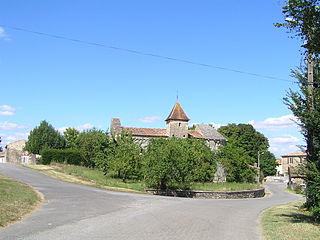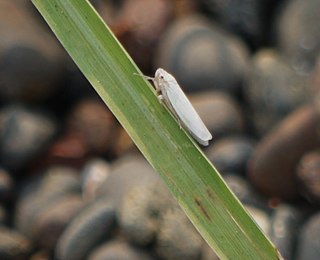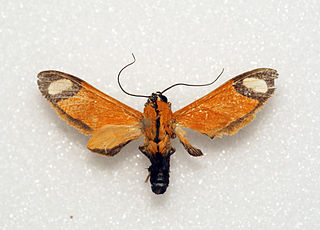Belfield is a village in the Demerara-Mahaica Region of Guyana, standing on the Atlantic coast, three kilometres west of Enmore.

Agylla, also formerly known as Churinga, is a genus of moths in the subfamily Arctiinae. The genus was erected by Francis Walker in 1854.
Apyre is a genus of moths in the family Erebidae. It was described by Francis Walker in 1854.

Empuré is a commune in the Charente department in southwestern France.

Mythimna separata, the northern armyworm, oriental armyworm or rice ear-cutting caterpillar, is a moth of the family Noctuidae. It is found in China, Japan, South-east Asia, India, eastern Australia, New Zealand, and some Pacific islands. It is one of the major pests of maize in Asia. The species was first described by Francis Walker in 1865.
Lamproxynella is a genus of tephritid or fruit flies in the family Tephritidae.
Erbessa clite is a moth of the family Notodontidae first described by Francis Walker in 1854. It is found in Brazil, Venezuela, French Guiana and Guyana.
Erbessa umbrifera is a moth of the family Notodontidae first described by Francis Walker in 1854. It is found in French Guiana, Guyana, Suriname and Brazil.

Endotricha is a genus of snout moths. It was described by Philipp Christoph Zeller in 1847.

Correbia lycoides, the tiger bug mimic, is a moth of the subfamily Arctiinae. It was described by Francis Walker in 1854. It is found in Mexico, Honduras, Panama, the amazon biome from Guyana to southern Brazil and Peru and on Cuba and Jamaica.

Cofana is a genus of leafhoppers belonging to the family Cicadellidae. Cofana species can be often found in grass habitats and in rice fields. Some species have been recorded on Dinochloa scandens (Poaceae). The genus Cofana is distinguished by their male genital morphology, with an aedeagus lacking paraphyses and basal processes. The hindwing lacks vein R2+3. Species in the genus are found in Africa, Asia, and Australia.

Hypomecis separata is a species of moth of the family Geometridae. It was first described by Francis Walker in 1863. It is found in Sri Lanka, India, Java and Borneo.

Glaucostola guttipalpis is a moth of the family Erebidae first described by Francis Walker in 1856. It is found in French Guiana, Guyana, Brazil, Ecuador and Costa Rica.
Hyalurga partita is a moth of the family Erebidae. It was described by Francis Walker in 1854. It is found in Brazil, Suriname, French Guiana and Venezuela.

Isostola divisa is a moth of the family Erebidae. It was described by Francis Walker in 1854. It is found in Brazil and French Guiana.

Ormetica contraria is a moth of the family Erebidae. It was described by Francis Walker in 1854. It is found in French Guiana, Guyana, Brazil, Ecuador, Peru and Bolivia.
Rhipha strigosa is a moth in the family Erebidae. It was described by Francis Walker in 1854. It is found in French Guiana, Panama, Venezuela and the Brazilian states of Pará, Rio de Janeiro and Amazonas.
Sphecosoma testacea is a moth in the subfamily Arctiinae. It was described by Francis Walker in 1854. It is found in Guyana.
Virbia subapicalis is a moth in the family Erebidae first described by Francis Walker in 1854. It is found in Brazil, Ecuador, Peru, Guyana, Suriname, Venezuela and Bolivia.









